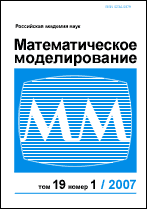|
|
Matematicheskoe modelirovanie, 1995, Volume 7, Number 9, Pages 72–78
(Mi mm1796)
|
 |
|
 |
Computational methods and algorithms
Dependence of continuous neutron activating logging on the tools velocity when long sondes are used
M. T. Minbaev
Novosibirsk State University
Abstract:
The process of a continuous neutron activating logging in a borehole configuration is considered. The formula modelling long sonde measured values is obtained. The dependence of an optimal velocity on a sonde length is investigated and results when greater velocities are used is researched. Some numerical modelling results for various sonde lengths are presented.
Received: 24.08.1993
Citation:
M. T. Minbaev, “Dependence of continuous neutron activating logging on the tools velocity when long sondes are used”, Mat. Model., 7:9 (1995), 72–78
Linking options:
https://www.mathnet.ru/eng/mm1796 https://www.mathnet.ru/eng/mm/v7/i9/p72
|

| Statistics & downloads: |
| Abstract page: | 270 | | Full-text PDF : | 152 | | First page: | 1 |
|




 Contact us:
Contact us: Terms of Use
Terms of Use
 Registration to the website
Registration to the website Logotypes
Logotypes









 Citation in format
Citation in format 